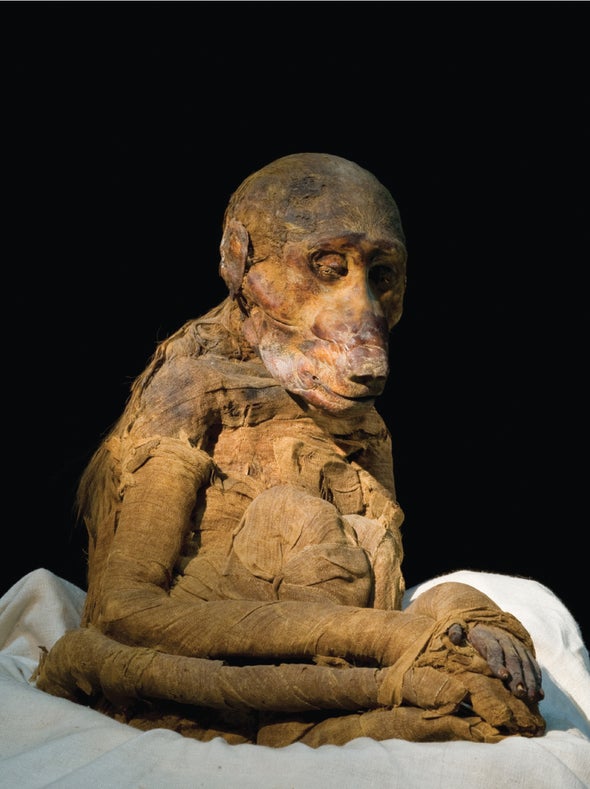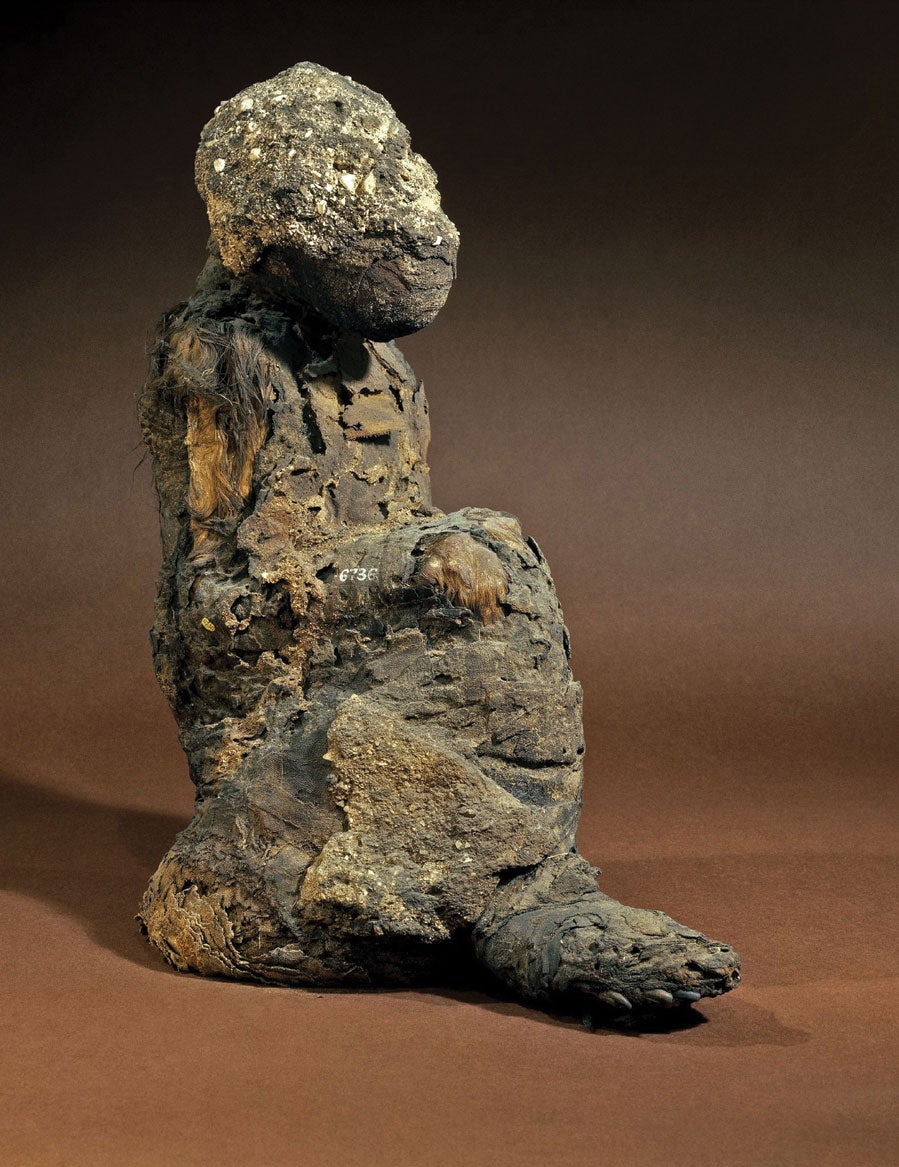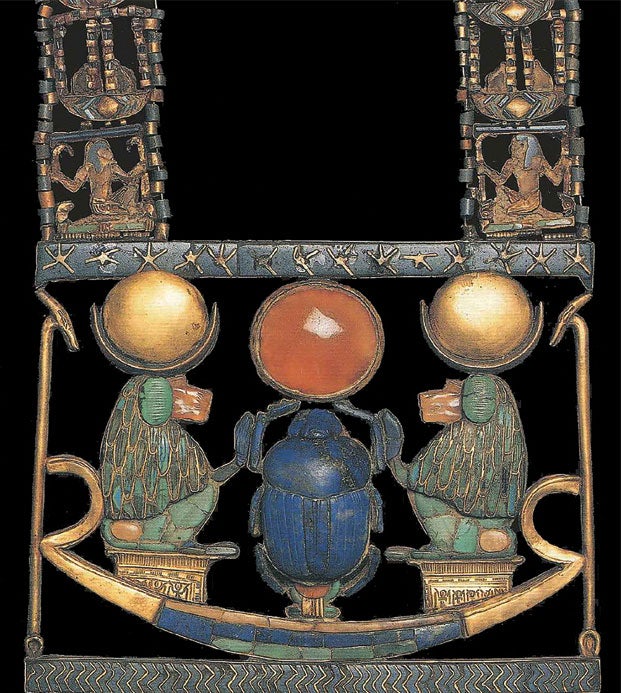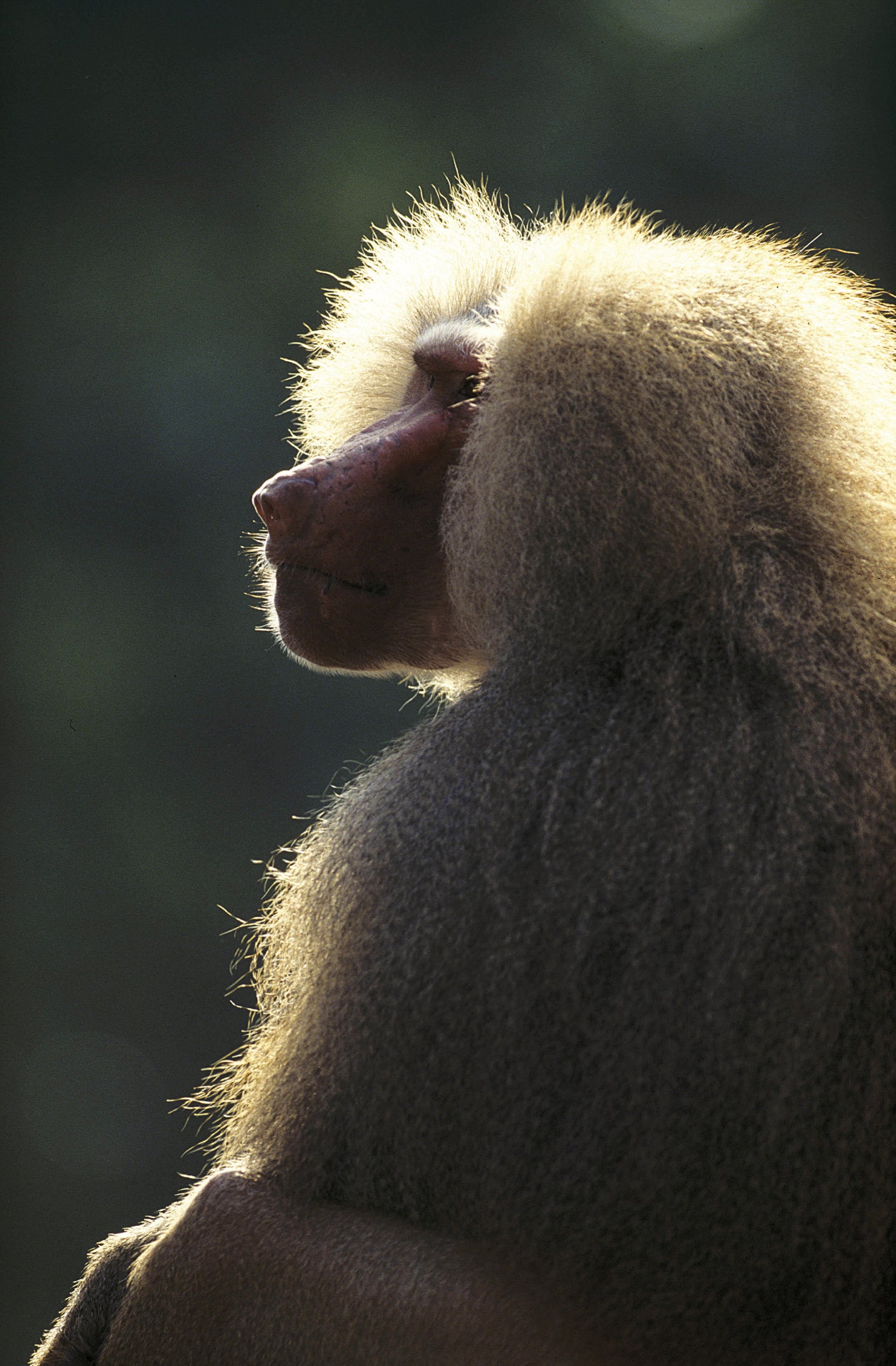Mysteries of Ancient Egypt's Sacred Baboons Revealed
Studies of living and mummified baboons hint at why ancient Egyptians revered these pesky primates and uncover the probable location of the fabled kingdom from which they imported the animals

In the collections of the British Museum in London, a mummy known simply as EA6736 sits in eternal repose. Recovered from the Temple of Khons in Luxor, Egypt, it dates to the New Kingdom period, from 1550 B.C. to 1069 B.C. Clues to the identity of EA6736 emerge after close inspection. Its painstakingly wrapped linen bandages have disintegrated in some places, revealing fur underneath. Stout toenails poke out from the bandages around the feet. And x-ray imaging has revealed the distinctive skeleton and long-snouted skull of a primate. The mummified creature is Papio hamadryas, the sacred baboon.
EA6736 is just one of many examples of baboons in the art and religion of ancient Egypt. Appearing in scores of paintings, reliefs, statues and jewelry, baboons are a recurring motif across 3,000 years of Egyptian history. A statue of a hamadryas baboon inscribed with King Narmer's name dates to between 3150 B.C. and 3100 B.C.; Tutankhamun, who ruled from 1332 B.C. to 1323 B.C., had a necklace decorated with baboons shown adoring the sun, and a painting on the western wall of his tomb depicts 12 baboons thought to represent the different hours of the night.
Egyptians venerated the hamadryas baboon as one embodiment of Thoth, god of the moon and of wisdom and adviser to Ra, god of the sun. The baboon is not the only animal they revered in this way. The jackal is associated with Anubis, god of death; the falcon with Horus, god of the sky; the hippopotamus with Taweret, goddess of fertility. Still, the baboon is a very curious choice. For one thing, most people who routinely encounter baboons regard them as dangerous pests. For another, it is the only animal in the Egyptian pantheon that is not native to Egypt.
Archaeologists have long puzzled over the prominence of the hamadryas baboon in ancient Egyptian culture. In recent years my colleagues and I have made some discoveries that bear on this mystery. Our work points to a biological explanation for the deification of the species. It also shows how the Egyptians obtained these exotic animals. Intriguingly, our insights into the sourcing of sacred baboons illuminate another enduring enigma: the likely location of the fabled kingdom of Punt.
An Odd God
"Baboons!" is an unwelcome cry at any six-year-old's birthday party. My family was living in Kenya when a troop of 20 baboons swaggered into our backyard, causing a great scattering of shrieking children. The invaders headed straight for the food table, which was neatly adorned with cupcakes, sliced fruit and juice boxes. They won the carb lottery that day, taking just minutes to fortify themselves with hours' worth of human labor. Setting aside my son's tears, the worst of it was watching the two males as they yawned in my direction. As a primatologist, I know that yawns are a pointed social signal, a way to advertise razor-sharp canine teeth that can cut a human limb to the bone with a single bite. In this context, however, the yawns seemed to convey not intimidation but full-bellied smugness.
When I recounted this tale to my Kenyan colleagues, it elicited knowing nods and a proverb: "Not all baboons that enter a maize field come out satisfied." Like many African proverbs, this one is layered with meaning. It alludes to the monkeys' insatiable crop raiding while simultaneously evoking sinister intent. Catherine M. Hill, a professor of anthropology at Oxford Brookes University in England, has found that baboons exact a devastating toll, reducing crop yields by half for some families in western Uganda. Indeed, baboons are the foremost pest for many subsistence farmers in Africa, and cultural aversions to the animals run deep. If erasure is the ultimate measure of contempt, then it is telling that in the art and handicraft traditions of sub-Saharan Africa, baboons are largely absent. This history makes the ancient Egyptians' worship of this creature—and its ubiquity in their art—deeply perplexing.


It is worth noting that modern baboons are typically divided into six species. All are native to sub-Saharan Africa and southwestern Arabia, and most people view them as pests. Researchers know from archaeological remains that the ancient Egyptians imported both Papio anubis, commonly known as the olive baboon, and P. hamadryas. But they deified only the hamadryas baboons, so any explanation for why the Egyptians revered baboons must account for their devotion to one species and not the other.
In their efforts to decode the significance of the hamadryas baboon, scholars have considered the way it is depicted in Egyptian art, noting two iconic forms. In the first, a male baboon sits on the thickened skin of its buttocks with its hands on its knees, its tail curled to the right and a disk representing the moon placed over its head. In the second, termed the gesture of adoration, the male baboon's arms are raised with palms upturned toward Ra, the sun god. Numerous Egyptian texts link baboons to Ra. For example, the ancient funerary texts known as the Pyramid Texts describe the baboon as the oldest or most beloved son of Ra. The Egyptian Book of the Dead explains that a suitable pronouncement of a deceased and newly resurrected person is, "I have sung and praised the Sun-disc. I have joined the baboons, and I am one of them."
To explain this connection between baboons and Ra, Egyptologist Elizabeth Thomas suggested in 1979 that the ancient Egyptians could have seen baboons face the rising sun to warm themselves and interpreted the behavior as their welcoming the sun. Her idea got a big boost a decade later, when the late Herman te Velde, another Egyptologist, elaborated on it by emphasizing the accompanying vocal behaviors of baboons, which he believed could have been taken as verbal greetings to the sun. Texts from the Karnak temple complex near Luxor describe baboons as "announcing" Ra while "they dance for him, jump gaily for him, sing praises for him, and shout out for him." In te Velde's view, people probably thought baboons were sacred because they seemed to communicate directly with Ra. The Egyptians saw the jubilance and inscrutable language of baboons as evidence of religious knowledge, he surmised.
Thomas's and te Velde's notions about what attracted Egyptians to these animals are fascinating, but are they plausible? Do baboons actually pay special attention to the morning sun? And are hamadryas baboons distinctive in this regard? Neither Thomas nor te Velde had much knowledge of primate behavior, and no primatologist had evaluated their ideas. Recently, however, findings bearing on these questions have emerged.
Many animals bask in the sun, an activity most biologists view as a way to minimize the energy cost of rewarming the body after a cold night. The ring-tailed lemurs of Madagascar, for instance, often face the morning sun in a posture resembling the lotus position of yoga but with extended legs. The late primatologist Alison Jolly once noted that Malagasy legend describes lemurs as worshiping the sun, holding their arms out in prayer. In 2016 Elizabeth Kelley, executive director of the Saint Louis Zoo's WildCare Institute, found that sun basking in these primates was strongly correlated with low overnight temperatures. Kelley and her colleagues also discovered that the skin of the chest and abdomen in these lemurs contains more melanin than the skin on the back, a reversal of the prevailing mammalian skin-color pattern. Melanin is a light-absorbing pigment, and greater amounts in the abdominal area facilitate not only warming but also digestion.

Primate studies carried out over the past few years indicate that baboons reap similar digestive benefits from soaking up the sun. The microbes that live in primate intestines are vital to the digestion of plant matter. A rising body temperature spurs microbe activity, which in turn increases the intestines' absorption of nutrients. Thus, sun basking is a simple and effective way for animals to jump-start their microbes in the morning. The benefits are twofold. First, digestion itself generates heat—good for warming a body chilled by the night air. Second, if a cold night slowed digestion during sleep, then it is both efficient and prudent for a primate to finish digesting yesterday's meal before searching for a new one.
It stands to reason, then, that some primate species should bask in the sun more than others, depending on where they live and what they eat. Hamadryas baboons live in arid habitats across the Horn of Africa and parts of Arabia. The western edge of their geographic range meets the eastern edge of the range of P. anubis in the Awash River Valley of Ethiopia, a setting that has long invited comparisons of ecological and behavioral differences between the two baboon species. Feeding observations reveal that hamadryas baboons eat more leafy plant tissues than olive baboons do, which means their diet is higher in fiber.

In theory, given their distinct diets, hamadryas and olive baboons should differ in the abundance and types of microbes they need to digest plant foods. Recent studies of the gut microbiomes of the two species conducted by biological anthropologist Steven Leigh of the University of Colorado Boulder and his collaborators, including me, bear this prediction out. We found that the hamadryas baboon has more so-called cellulolytic microbes—which break down plant cell walls—than the olive baboon does, in keeping with its higher-fiber diet. The upshot of these findings is that the hamadryas baboon appears to have more to gain from early-morning sunbathing than the olive baboon has.
Our gut microbiome findings corroborate Thomas's hypothesis that Egyptians witnessed hamadryas baboons "welcoming the sun-disc." They may also explain why Egyptians venerated P. hamadryas over P. anubis: perhaps its dietary ecology produced morning behaviors that resonated more strongly with their religious beliefs.
A Lost Land
Whatever the reason for their devotion to this species, ancient Egyptians went to great lengths to acquire living hamadryas baboons. Their demand for these animals, as well as for other luxury goods, including gold, incense and ivory, became a market force that shaped the course of world history.
In 1906 Theodore M. Davis, a colorful American lawyer and financier, discovered five mummies of P. hamadryas in the Valley of the Kings. The mummies came from tombs attributed to either Amenhotep II or King Horemheb, both of whom were members of the first dynasty of the New Kingdom, a period of great prosperity. The tomb of Amenhotep II's father, Thutmose III, contained a P. hamadryas skull that had apparently been unwrapped and then jettisoned by discriminating tomb raiders. Although baboons are depicted in older Egyptian art, these mummies represent the earliest-known physical remains of hamadryas baboons in Egypt. The abrupt appearance of P. hamadryas in these funerary contexts suggests that it was imported at great expense. Salima Ikram, a professor of Egyptology at the American University in Cairo, has argued that these baboons were cherished pets as well as exotic status symbols. Their presence in royal tombs and the high quality of their mummification—using prodigious lengths of the finest linen—speak to their value. Only the wealthiest Egyptians could afford this superior means of preserving bodies for the afterlife.

To determine where ancient Egyptians got their hamadryas baboons, my colleagues and I analyzed two mummies, one of which was EA6736. Both specimens had been purchased by Henry Salt, British consul general in Egypt from 1816 to 1827, and were later acquired by the British Museum. Although the ages of these mummies are not known as precisely as those of Davis's mummies, considering their style of wrapping and the fact that they came from Theban temples, they were probably mummified during the New Kingdom period.
Texts and inscriptions from this time indicate that the Egyptians used their port at Mersa Gawasis to conduct maritime expeditions to the mysterious kingdom of Punt, a faraway realm of luxury goods that was said to exist "in God's land." The global historical importance of Punt is considerable. British historian John Keay described the sea route to Punt as the first long step in the spice route, a trade network that drove maritime technologies and shaped geopolitical fortunes for millennia. But there is a problem, as archaeologist Jacke Phillips observed in 1997: "Punt has not yet been located with certainty on any map, and no archaeological remains have ever been identified, even tentatively, as 'Puntite.'"
If Egyptians obtained hamadryas baboons from Punt, then tracing the geographic origins of the mummies more specifically might allow us to pinpoint the location of this legendary place.
Luckily, we can reconstruct the lifetime movements of the baboons that were mummified by examining the chemical compositions of their tissues. My colleagues and I focused on the element strontium because its composition in bedrock differs from place to place. The strontium is absorbed by the surrounding soil and water and enters the food chain when animals eat plants that grow in the soil and drink the local water. Strontium in an individual's teeth, which develop early, can thus reveal where it was born; strontium in bone and hair, which change throughout life, can show where it lived just prior to death.
We compared the strontium compositions of the mummies' bones and teeth with those of baboons living in various regions across Africa. Our spatial analysis of these chemical profiles indicates that the animals were born outside Egypt in the southern Red Sea region, which encompasses the modern-day countries of Ethiopia, Eritrea, Djibouti and Somalia. Gratifyingly, historians have previously highlighted these areas as potential locations for Punt on the basis of written accounts, as well as images of plants and animals on the walls of Egyptian temples and tombs. A great strength of our result is that it puts Punt within the natural distribution of P. hamadryas.
The revelation that baboons were imported alive from the southern tip of the Red Sea is a testament to the astounding reach of Egyptian mariners during the second millennium B.C., demonstrating that they could sail at least 1,300 kilometers each way in open boats without a keel or rudder. It must have been a treacherous journey, and it is perhaps no accident that one of the most famous narratives in Egyptian literature is The Tale of the Shipwrecked Sailor, which tells the story of an Egyptian sailor who washes ashore on a magical island in the Red Sea.
We still have much to learn about ancient Egyptian religious beliefs and trading practices. As we move forward, it would be useful to examine the morning behaviors and melanization patterns of hamadryas baboons and to see whether they support the hypothesis that this species is especially dependent on the morning sun. Our work also underscores the importance of searching Eritrea and neighboring countries for corroborating archaeological evidence, such as Egyptian products, that could speak to Punt's location.
One wonders what the Puntite traders thought of the Egyptians' obsession with baboons. It is tempting to speculate that they were only too eager to exchange a local pest for Egyptian trade goods. But we have that cultural idiosyncrasy to thank for illuminating one of the most important trade routes in human history.
This article was originally published with the title "Secrets of the Sacred Baboons" in Scientific American 325, 5, 46-53 (November 2021)
doi:10.1038/scientificamerican1121-46
-- Sent from my Linux system.
No comments:
Post a Comment